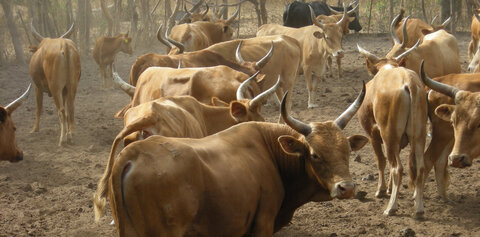What are the symptoms of animal trypanosomiasis?

Nagana
The various species of trypanosome produce various ill effects in different species of livestock, but they are all collectively referred to as trypanosomiasis. Mixed infections may occur, with corresponding variations in clinical disease.
The general patterns are shown in the table below.
Trypansomes and trypanosomiasis
Species |
Stock affected |
Nature of the disease |
|---|---|---|
|
T. brucei |
Horses, dogs, cattle, pigs, sheep and goats. |
Infections in cattle and pigs, disease is mild and self-cure is usual.
|
|
T.congolense |
Horses, cattle, sheep, goats, pigs and dogs. |
Typically, a chonic wasting infection, often fatal. The disease can sometimes be acute. Pigs are least affected. |
|
T. simiae |
Pigs and occasionally ruminants. |
Rapidly fatal in domestic pigs. |
|
T. vivax |
Cattle, sheep, goats and, rarely, horses. |
Great variation in strains, ranging from a chronic wasting disease which may |
Symptoms of nagana in cattle
An infected ox becomes progressively thinner. The hair has a characteristic rough and upstanding appearance (‘staring coat’) and the skin is drawn tightly over the ribs and pelvis and lacks the looseness of healthy animals. There may be discharge from the eyes, varying between a copious weeping with photophobia (avoidance of light by closing the eyes) to a slight but definite crusting of the discharge at the inner corner of the eyelids. This condition is more typical of T. vivax infections, which may also produce visible swellings of the superficial lymph nodes. The tail bush may fall out, but this is a variable sign, commoner in young animals.
The animal becomes listless, it lags behind the herd, loses interest in its surroundings, its ears and tail hang limply and it ceases to react to biting insects.
The signs of disease appear 11-21 days after an infective bite as a relapsing fever, with temperature peaks. These peaks are associated with an increase in the numbers of trypanosomes in the circulating blood, followed by the destruction of large numbers of the parasites and a return to a normal temperature. The end of the period of parasite destruction is the crisis, when antibodies are being produced and large quantities of trypanosome protein are liberated into the bloodstream. Death commonly coincides with a crisis. In areas where reinfection is frequent, death will commonly occur within one to three months, unless the animal is treated with a trypanocide.